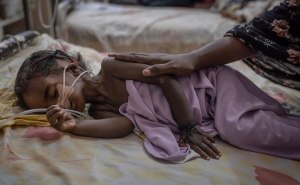Maternal Undernutrition Linked to Early Life Onset of Child Growth Failure in Low-Income Settings
A collection of studies published in Nature found that the first three months of life was the most vulnerable period for growth faltering in newborns, suggesting nutrition and health interventions targeting women of childbearing age and pregnant women as well as children under six months of age may be key for prevention.
The studies were spearheaded by Parul Christian, DrPH '96, MSc, a professor of International Health at the Johns Hopkins Bloomberg School of Public Health and the director of the School’s Center for Human Nutrition, while she was a senior program officer at the Bill & Melinda Gates Foundation working with the Knowledge Integration initiative. The studies were led by researchers at the University of California and Stanford University, with several International Health co-authors. The Department’s JiVitA Project in Bangladesh, which Christian leads, was an important source of data for the studies.
This research offers one of the most comprehensive looks yet at how maternal nutrition may influence child growth in early life during the fetal period and when breastfeeding is the main source of nutrition.
Child Growth Patterns and Predictors
Wasting and stunting affect an estimated 45 million and 149 million children under the age of 5 years worldwide, respectively. Children who experience these conditions are predisposed to infections and severe illness, experience poor neurocognitive development, and have an increased risk of mortality.
In this big data analytic effort utilizing multiple longitudinal research studies and involving birth cohorts from South Asia, sub-Saharan Africa, and Latin America, with over 100,000 infants who were followed from birth through 24 months of age, researchers analyzed longitudinal weight and length data to determine when in the first two years of life the onset of stunting and wasting was the highest. They identified that the onset of stunting (being short for one’s height) and wasting (being thin for one’s age) were highest at birth through three months of life, even though the prevalence peaks at 24 months of age.
This analysis was unique in estimating that 20 percent of newborns in South Asia were stunted at birth. It also found that more children experienced wasting at some point in their first 24 months of life than was previously estimated. In South Asia more than 50 percent of children experience wasting by their second birthday.
Infants who experienced stunting before 15 months of age had low rates of reversal and even those with reversal of stunting often relapsed frequently. In contrast, infants whose onset of wasting was before six months of age had faster recovery compared to those who became wasted at older ages. However, this early onset of wasting predisposed them to recurrent episodes of wasting, developing stunting and growth faltering later, and increased risk of mortality.
A correlation between the season of a child’s birth and the prevalence of wasting was also identified. The highest incidence of wasting was seen in the rainy season, perhaps reflecting the presence of seasonal food insecurity in crop-reliant regions, and supporting the need for prenatal interventions that support the nutritional needs of expectant mothers and the potential for specific seasonally targeted interventions.
Future Interventions
These studies reveal the importance of creating pregnancy and possibly preconception targeted interventions to improve maternal nutritional and overall health, such as nutritional supplements and counseling, which may help curb the onset of early life wasting, stunting, and growth faltering in newborns and children. The presence of early wasting was shown to greatly impact child health and development and identified the need for interventions during lactation and infant feeding support. Maternal and early postnatal interventions are urgently needed in addition to ongoing efforts to promote optimal growth and development among children 6-24 months of age.
Read the complete studies in Nature.
Early-childhood linear growth faltering in low- and middle-income countries
Causes and consequences of child growth faltering in low-resource settings
Child wasting and concurrent stunting in low- and middle-income countries





